Burning the Midnight Oil for Living Energy Independence , crossposted from The Hillbilly Report
 It is widely remarked that the US Department of Transport map of High Speed Rail Corridors leaves a lot of obvious holes.
It is widely remarked that the US Department of Transport map of High Speed Rail Corridors leaves a lot of obvious holes.
Often, this reflects a misunderstanding of what the DoT is mapping. This is not a “Master Plan”. There is no HSRail planner division inside the Federal Rail Administration inside the Department of Transport that is working away at deciding which corridor should be added to the corridor.
Instead, what they have mapped are the corridors that are eligible for HSRail funding. The way that things are set up is that a state or group of states do some planning, petition Congress be designated as a HSRail corridor, or added to a corridor, or for less sweeping changes petition the Department of Transport to revise an existing corridor, and {*voila*}, that’s a designated corridor.
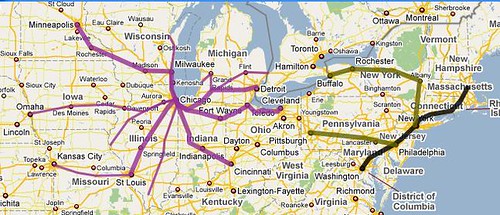 Since the corridor is a funding category, there are lots of HSRail corridors that are not on the DoT map. For example, compare the corridor map to the full Midwest Hub which is, formally, the “Mid-West Regional Rail System”, a hub and spoke system centered on Chicago.
Since the corridor is a funding category, there are lots of HSRail corridors that are not on the DoT map. For example, compare the corridor map to the full Midwest Hub which is, formally, the “Mid-West Regional Rail System”, a hub and spoke system centered on Chicago.
Some of the “missing lines” are not 110mph lines, but some – like Milwaukee to Green Bay, or Kalamazoo to Port Huron – are planned for 110mph.
So why are they missing? Because they are not planned for immediate construction. Kalamazoo/Grand Rapids and Kalamazoo/Port Huron would not be started until Chicago/Detroit is running as an HSRail corridor. Milwaukee/Green Bay would not start until Chicago/Milwaukee is running as an 110mph service. There is no reason to seek designation for these branch corridors until the corridors they branch out from are under construction and nearing completion.
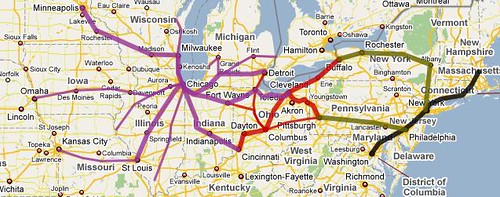 Looking at the full Midwest Hub from a Buckeye perspective, there is one real obvious gap – the Cleveland/Columbus/Cincinnati route – the “Triple-C”. And, as you can see above, the Triple-C planned for by the Ohio Rail Development Commission (ORDC) in their Ohio Hub plan, was added to the Midwest HSRail corridor system.
Looking at the full Midwest Hub from a Buckeye perspective, there is one real obvious gap – the Cleveland/Columbus/Cincinnati route – the “Triple-C”. And, as you can see above, the Triple-C planned for by the Ohio Rail Development Commission (ORDC) in their Ohio Hub plan, was added to the Midwest HSRail corridor system.
But the Ohio Hub is much more than just the Triple-C. It reaches out to connect to the East Coast via Buffalo and the Empire Corridor and Pittsburgh and the Keystone Corridor, and direct connections for southern and central Ohio to Detroit and Chicago. However, it is a staged plan, and the Triple-C is the first stage, so that is all that shows up on the Federal map.
Some Gaps Really Are Gaps
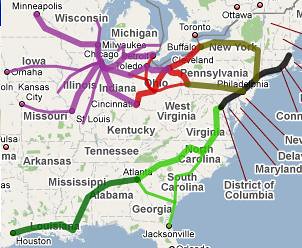 Some gaps in the corridor map, however, are exactly that: gaps. East of the Mississippi, the biggest gap is right smack dab in the middle: Kentucky, Tennessee, and West Virginia. The only plans that I am aware of that even touch these states are a maglev proposal from Atlanta to Chattanooga, and the designation of Indianapolis to Louisville in the Federal corridor map – which is not, note, part of the most recent Midwest Hub.
Some gaps in the corridor map, however, are exactly that: gaps. East of the Mississippi, the biggest gap is right smack dab in the middle: Kentucky, Tennessee, and West Virginia. The only plans that I am aware of that even touch these states are a maglev proposal from Atlanta to Chattanooga, and the designation of Indianapolis to Louisville in the Federal corridor map – which is not, note, part of the most recent Midwest Hub.
And in general, in what will be no news to anybody who grew up in or near Appalachia, very few routes are planned to run through Appalachia at all.
The Keystone Corridor extended by a later stage of the Ohio Hub runs east to west through the far northern end of Appalachia, while the Gulf Coast corridor swings through Birmingham, Alabama, so its got to run into the far southern end of Appalachia. The Southeast Corridor skirts the eastern edge Appalachia. But West Virginia, Eastern Kentucky, Eastern Tennessee, Western Virginia … pretty much nothing.
You might think, “but, this is terrible terrain for High Speed Rail, its normal that there are few High Speed Rail corridors planned”.
 Except – the HSRail system has that problem covered.
Except – the HSRail system has that problem covered.
Tilt-Trains and Appalachian Rail
The Federal designation of “High Speed Rail” actually covers three distinct tiers of High Speed Rail. The top tier, “Express HSR”, are the bullet trains that most people think of when they hear HSR. And bullet trains through mountainous terrain are massive undertakings, with tunnels connecting to viaducts connecting to tunnels. For the size of most of the cities and towns of Appalachia – even when connecting them to a large metropolis – it is very hard to justify the cost per mile in terms of the available ridership.
But the second and third tiers, the 125mph “Regional HSR” and 110mph “Emerging HSR”, are different. These are the speeds you can get to on existing right of way with modern “tilt-trains”.
You can’t just run at 110mph on an existing right of way without upgrades, of course. The track sometimes has to be upgraded to take 60mph rail traffic. All level crossings have to be upgraded to standard above the 79mph standard. The signaling has to be upgraded. Still, the new grade-separated right of way designed for trains running 220mph is the biggest cost of an Express HSR system, and that is not needed for an express tilt-train system.
That is why, after all, the Midwest Hub, Ohio Hub, Empire Corridor, Keystone Corridors, Southeast Corridor and Gulf Coast Corridor are all planned for 110mph or 125mph tilt-train systems. There are quite a lot of cities that can be connected for two to three hour trips via 110mph or 125mph trains, and connecting them with Emerging HSR and Regional HSR corridors allows five to ten times as many route-miles as an Express HSR system.
So, what is a tilt-train, and why is it important?
The top speed of a train only has a loose relationship with the travel time between two places. The problem is curves. A passenger train needs to bank to go through a curve at speed, to avoid tossing the passengers inside around like so much loose baggage.
Problem is, when you are sharing track between passenger trains and freight trains, banking the track to allow for faster passenger trains leaves a slower freight train unbalanced, causing excessive wear, for higher maintenance cost and increased risk of derailment. And a heavy freight train has to go slower, because a trestle that can handle a passenger train with 17 tons per axle at 110mph cannot necessarily take a heavy freight train with 33 tons per axle at 100mph.
So, as the Japanese, Spanish and Italians have worked out over the last thirty years, a key trick to sharing track between 110mph passenger trains and slower heavy freight trains is for the fast passenger train to do part of the banking itself. This is the “tilt-train”.
And the more curves, the more benefit the tilt-train provides. Indeed, for the existing Amtrak routes through Appalachia, such as the DC/Cincinnati route through West Virginia, a tilt-train running at 79mph would be faster than a regular Amtrak running at 79mph.
Actually, a 110mph tilt-train can be more energy efficient than a 79mph train on a typical Appalachian alignment. While the the 79mph is constantly slowing down for tighter curves curves and then speeding up to go through looser curves, the 110mph is able to maintain a much steadier speed.
Network Economies and the Appalachian Hub Stage 1
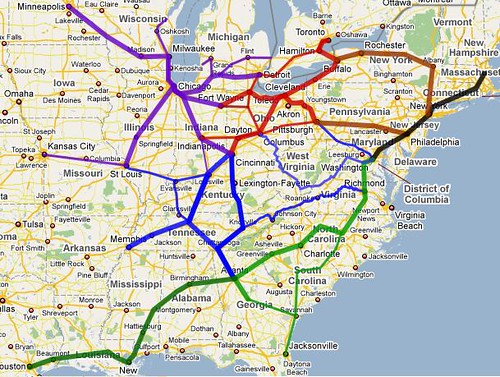 The “Appalachian Hub” sketched here – and I stress that this is just a back of the envelope concept, and there is absolutely no state rail planning agency behind this unless people in these states make it happen – fills in the big hole in the middle of the current state plans east of the Mississippi.
The “Appalachian Hub” sketched here – and I stress that this is just a back of the envelope concept, and there is absolutely no state rail planning agency behind this unless people in these states make it happen – fills in the big hole in the middle of the current state plans east of the Mississippi.
You may notice that one of the striking features of this Appalachian Hub is how much of it lies outside of Appalachia. The reason for that is simple. While the Great Lakes states, Southeast Coast states, and Gulf Coast states have at least got systems up on the drawing boards that Appalachian rail corridors can connect to … it seems like the state governments of Kentucky and Tennessee have been laying down on the job.
So the first stage is to complete the hole in the ring around Appalachia, with a corridor from Atlanta to Chattanooga to Nashville to Louisville to Cincinnati. As noted on the map, the Nashville to Cincinnati leg could also be usefully extended to Memphis.
Access to an 110mph route at Chattanooga opens up the door to an Amtrak speed route from Knoxville to Chattanooga, which can be incrementally upgraded to 90mph then 110mph. When it reaches 110mph, that opens the door to a through route from Atlanta to Knoxville, which can run through to Lexington and on to Cincinnati.
The ultimate target for these corridor would be electrification and signal and level crossing upgrades to allow them to run at 125mph.
Stage 2: The Real Appalachian Hub
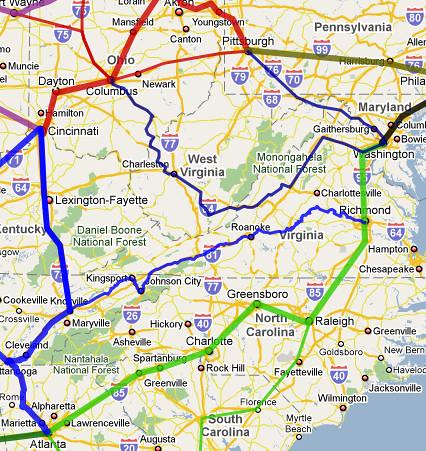 Even with these corridors in place, there are still a big hole in the map. Much of the hole represents the Appalachian mountains themselves. But of course, they have mountains in Spain, Italy and Japan – that’s why they led the way in developing tilt trains.
Even with these corridors in place, there are still a big hole in the map. Much of the hole represents the Appalachian mountains themselves. But of course, they have mountains in Spain, Italy and Japan – that’s why they led the way in developing tilt trains.
The northernmost east-west link is the existing Amtrak route through the eastern pandhandle of West Virginia from Pittsburgh through to Washington DC. That ties into the Keystone Corridor and Ohio Hub at the western end, and the Northeast Corridor and Southeast Corridor at the eastern end.
The second east-west link in the map runs into the Appalachian foothill counties of Ohio that are excluded from the Ohio Hub, then to Charleston, West Virginia, then on to Washington DC on the existing Cincinnati/Washington Amtrak route.
The third east-west link on the map runs from Knoxville, Tennessee through the TN “tri-cities” of Kinsgport, Johnson City, and Bristol, and then through Western Virginia to Roanoke and on to Richmond.
Now, it looks like the second and third east-west links run awful close to each other, and on the state map it looks like it might be possible to crosslink those, with the existing Cincinnati/Washington route through Charleston, WV, connecting to a Columbus/Richmond line. However, while I am still on the look-out for a useful rail link to make that cross-connect – so far the miles between the two routes seem to be “mountain miles”, and it might be that no real useful route exists.
Wait a minute, what about the owners?
This whole business of “sharing right of way” sometimes means laying new track in a sliver of a right of way bought off a railroad … and sometimes means sharing track owned by a private railroad.
Won’t they mind? Many railroads are awfully grumpy hosts for Amtrak, and if an Amtrak service is fifteen minutes late for a scheduled slot, some rail operators will think nothing of putting a coal train in that slot instead that will stretch the delay out to hours.
Even where these Emerging HSR corridors share track used by freight railroads, they will be upgrading track and corridor to 60mph capacity, and installing somewhere around 10 miles of passing track for every 50 miles of track. That allows the HSR services to run through without being interrupted by freight service. But it also means that there is an increase in freight capacity without cost to the freight operator.
The HSR corridors will also see a number of trains per day each way, at a rate negotiated up front, with each train paying an access fee for use of the track, which is a better source of income than one (or fewer) Amtrak service each way.
Finally, one of the things that has been driving the push to single-track rail corridors is the fact that railroads, unlike public roads and airports, pay local property taxes. The new improvements to serve the HSR corridors will typically be owned by a public authority, so the private railroads gain this new capacity without an increase in their property tax burden. At the same time, for many small towns the railroad can be their only commercial property tax income, and this approach avoids disrupting their local tax base.
Conclusions? This is just Part 1
This is a work in progress, and I am sure there are glitches, flaws, etcetera all the way through. Next time I look at the Appalachian Hub (no promises on how many weeks it will be), I will be doing back-of-the-envelope comparisons of the transport market along these corridors compared to some of the other HSR corridors already on the map.
Of course, if you find one of those glitches, I’d thank you for that. Also stories about transport in the are, criticism, praise, sharing the link around to friends of Appalachia and friends and enemies of High Speed Rail alike.
So for now, I’ll open the floor for discussion.

25 comments
Skip to comment form
Author
… first when Appalachia enters the conversation, but Teddy also reminds us that a progressive majority is built from the bottom up, not from the top down.
…smack dab in the center of the Omega-loop (Round Knob) of the 7-mile extension of Norfolk-Southern (now plus CSX) grade over the Eastern Continental Divide. All freight now, but once hosted ample passengers, with a nifty 120-foot tall geyser man-made at the bottom of my driveway that could be seen at seven different points as the train negotiated the loops.
They’ve been trying to get passenger service to Asheville for some years, beyond the autumn steam train excursions. From there one can travel anywhere, it’s atop the Appalachian plateau. We rebuilt our station with federal grants and everything. The passenger trains still don’t come here.
You can’t go fast over the divide. At least, not on any existing grade on this side. But it’s a beautiful ride. Wish it would happen.
If HSR is built in the Appalachians, then the people living there and “trapped” by few economic opportunities may have a means to travel to where jobs are.
Would it be possible to live in WV and work in DC?
They have a train to Wawa. The indians still use it and tourists. It is anything but high speed rail.